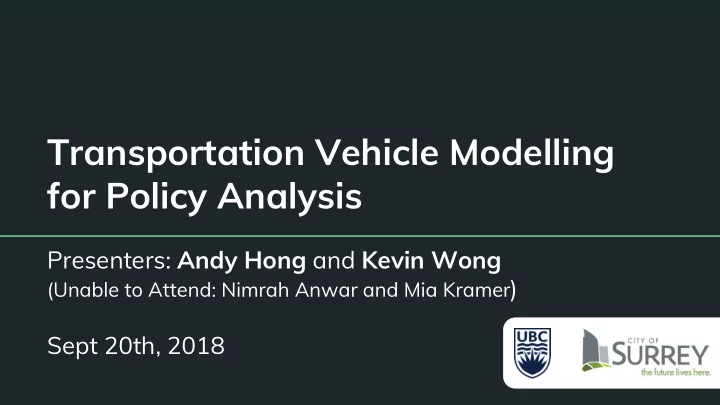

Transportation Vehicle Modelling for Policy Analysis Presenters: Andy Hong and Kevin Wong (Unable to Attend: Nimrah Anwar and Mia Kramer ) Sept 20th, 2018
Transportation Contributes the Majority of GHG Emissions Baseline Emissions (2007) 4% 37% 59% Source: City of Surrey Community & Emissions Plan, 2013:34
Our Planned Deliverables Vehicle Stock Insights Policy Analysis Tools How has vehicle ownership If we meet particular targets changed between 2006 and for vehicle stock composition, 2016? how will that affect GHG emissions? What other factors correlate with different vehicle stock What areas of Surrey composition? provide the best opportunity for reducing GHG emissions?
Our Project Data Process ICBC vehicle registration 1 1. Data Collections and Cleaning ● Transportation demand model output 1 ○ Spatial Rebasing ● 2. Exploratory Data Analysis Building and population projections 1 ● 3. Vehicle Stock Regression Modelling Census / StatCan data ● ○ Demographic, Transportation, 1 Thank you to the City of Surrey for Spatial/Temporal elements providing these non-open data. 4. Transportation Demand Classification by vehicle class 5. Emissions Modelling
Geographical Rebasing ICBC Registration: Transportation Models: Census: Postal Codes Traffic Analysis Zones Dissemination Area Sources: City of Surrey, StatCan, Canada Post
Geographical Rebasing—Postal Codes Approximate Postal Code catchment areas with their centroid. Sources: Canada Post, Google Maps API, geocoder.ca
Geographical Rebasing—Census Data Goals of rebasing census data: - Develop a TAZ-level table or database of all census variables relevant to transportation models (e.g.: vehicle stock models) - Standardize all selected census variables across different years to a common set of variables Issues with rebasing census data: - No readily available interpolation / distribution algorithms - Census population and housing stock may be under-estimated - Census specification and vector names varies across the years. - Standardization requires extensive “manual” adjustments Resultant: 3 Census data table of 369 standardized variables for 374 TAZs
Vehicle Stock—Distribution of Vehicle Stock Green Vehicles early in its adoption, Further analysis focused on Passenger vehicle stock Source: ICBC Registration Commercial Passenger
Vehicle Stock—Visualizing Vehicles Per Capita Percent Change of Passenger Vehicles Per Capita Between 2006 and 2016 Source: ICBC Registration
Vehicle Stock—Visualizing Vehicle Net Weight Histogram of Vehicle Net Weight in 2006, 2011, and 2016 Source: ICBC Registration
Vehicle Stock—Changes in Vehicle Attributes Source: ICBC Registration
Vehicle Stock—Next Steps and Data Gaps 1. Contextualize Findings: Variable Exploration with Demographic Variables Understanding how vehicle ownership has changed in relation with other key demographic ○ variables 2. Hypothesis Testing & Modelling: Obtain Unique Vehicle ID Between Years Apply statistical testing for rigorous inference ○ Develop vehicle aging model to better understand vehicle ownership dynamics ○ Source: ICBC Registration
Vehicle Classification Purpose Method Needed Vehicle Adopted classification Classification Scheme to scheme from FuelEconomy , a various Make and Models collaboration between U.S. that is not provided by ICBC Department of Energy and dataset the Environmental Protection Agency (EPA) And Fuel Consumption Ratios for passenger vehicles based on make, model, and year
Vehicle Classification We decided to adopt a classification scheme from FuelEconomy which is a ● collaboration between U.S. Department of Energy and the Environmental Protection Agency (EPA) This classification offered us not only sufficient detail (with regards to different ● types of vehicles), it also provided us fuel consumption ratios for passenger vehicles based on make, model and year
Vehicle Classification—Result 5,152 Different Veh Models Cars Trucks Two - Seater Pick - up Trucks ● ● 12 Mini - Compact Vans ● ● Subcompact Minivans ● ● Compact SUVs ● ● Midsize Special Purpose ● ● Vehicle Large Vehicles ● Classes Station Wagons ●
Vehicle Classification Two - Seaters Pick - up Trucks Mini - Compact Vans Subcompact Cars Trucks Minivans Compact SUVs Midsize Large Special Purpose Vehicles Station wagons Defined by Interior Volume Defined by Gross Vehicle Weight Rating (GVWR)
Vehicle Classification—Distribution in ICBC Registry
Vehicle Stock Forecasting Goal - Provide Business-As-Usual (BAU) vehicle stock size forecasts for City of Surrey beyond the year of 2016 Challenges - Need to account for geographic effects w/o necessarily interpreting them - Need to account for effects of vehicle class - Limited dataset size (only 3 time points) - Time series methods unfeasible - Omitted variables may affect accuracy of the forecast - For regression models, need future values of independent variables
Vehicle Stock Forecasting Approach - Fit models at three geographic levels: city, community and TAZ - Community models are the most sensible considering the data size - Independent variables available: Year, Surrey Population & Housing - WARNING: These prediction models do not yield valid and useable coefficients - Models are continuously modified to improve fit and diagnostics Final community-level model - Vehicle counts per community and vehicle class as a function of the community and community total units - Variance of the model follows a log-normal distribution R 2 = 92%, Deviance Explained = 92.3%, with a sample size of 273 - - Reasonable model diagnostics
Vehicle Stock Forecasting
Vehicle Stock Forecasting
Vehicle Stock Forecasting
Vehicle Stock Forecasting
GHG Emission Inventories Methodology FuelEconomy FuelEconomy ICBC Vehicle Distance Fuel Approximate × × Total Fuel × Emission = Stock Travelled Consumption CO 2 emissions Volume Factors (number & type) (average, per type) (average, per type) (by vehicle and fuel type) Demand Model (under development) Source: IPCC (2006) IPCC Guidelines for National Greenhouse Gas Inventories. Volume 2, Chapter 3.
Next Steps 1. Regression Modelling of Vehicle Stock with Demographic Variables 2. More Advanced Modelling of Vehicle Stock (Markov Chain, Stock-Flow) 3. Validate and Redevelop Vehicle Stock Model with More Data 4. Compute GHG Emissions based on Vehicle Stock Forecasts once Transportation Demand Data is Made Available
Policy Analysis Tool We’ve developed an interactive tool for planning and testing the outcomes of different policies in the City of Surrey.
Questions?
Recommend
More recommend